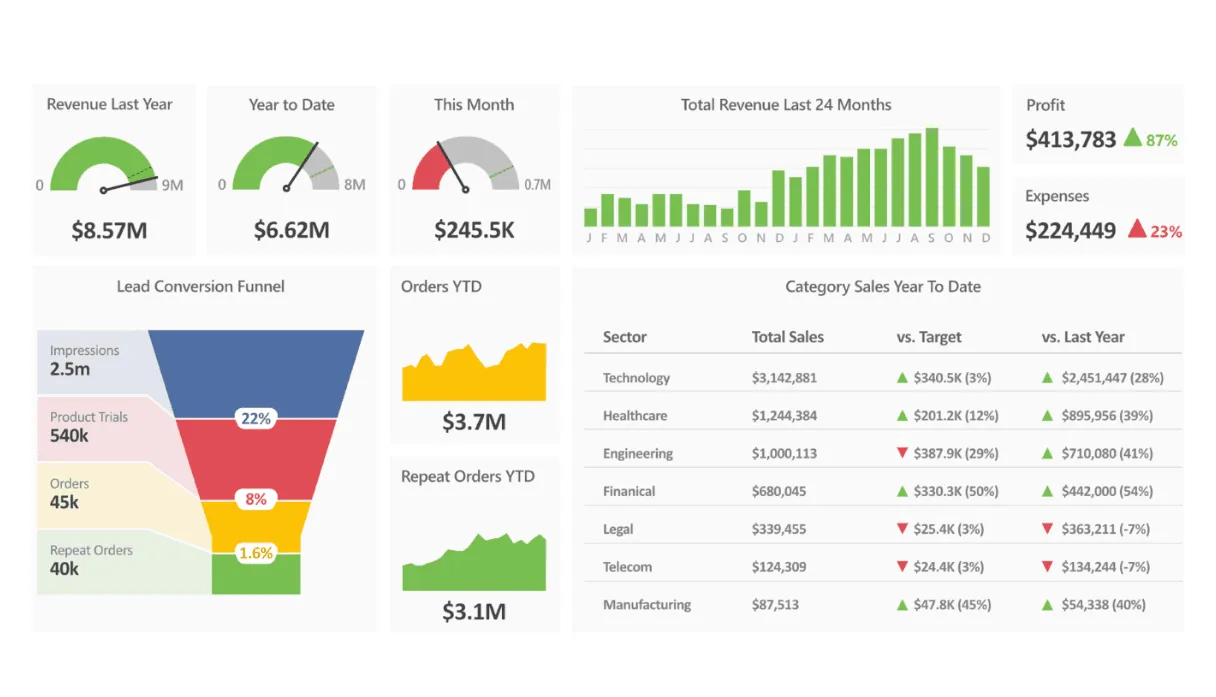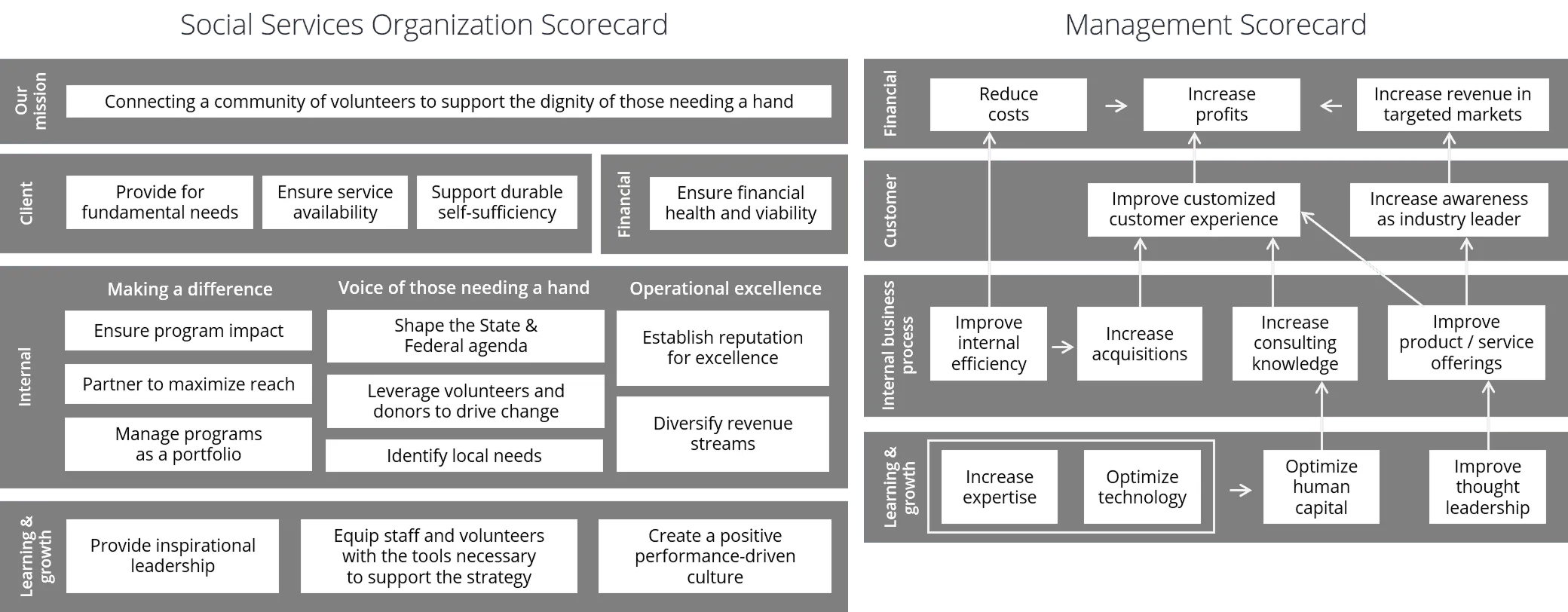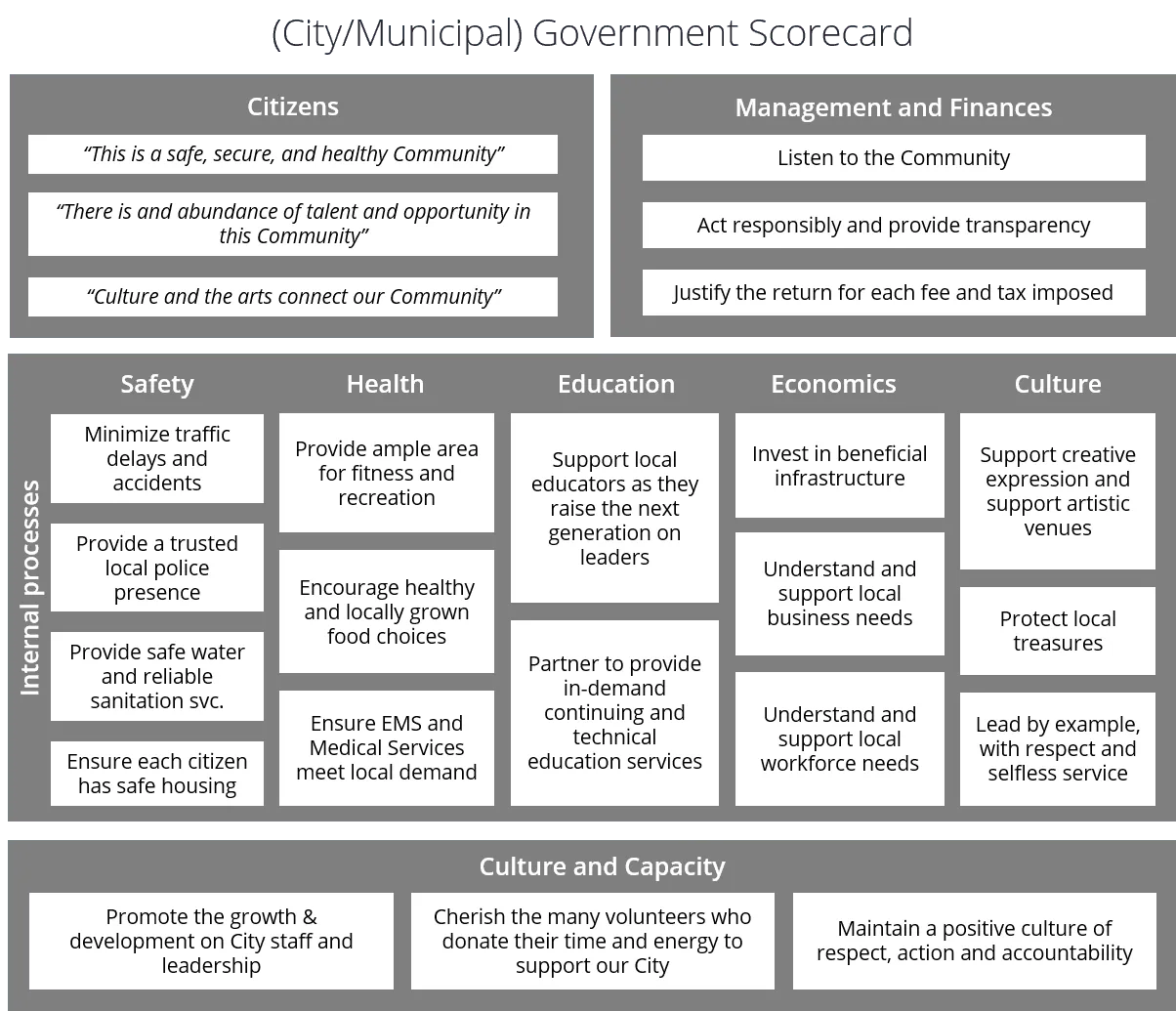Overview
Smart organizations plan their development over both the short and long term. This involves coming up with a solid strategy that requires systematic monitoring and tracking to determine if it is put to good use. However, measuring the effectiveness of a strategic plan is not always simple, especially if companies rely only on a limited set of indicators (usually financial metrics) to do so.
For enterprises to gain a better understanding of their health and success, they need to look at the non-financial aspects of their activities as well. To allow a more comprehensive examination of business strategic performance, the concept of the balanced scorecard was developed.
On this page, we will walk you through the basics of this strategy planning and performance management tool, covering the following notions:
1. The balanced scorecard: definitions, terminology, model structure
What is a balanced scorecard (BSC)?
A balanced scorecard (BSC) is a business framework used to implement and manage an organization’s strategy. It examines internal business processes and external outcomes to determine how a company is performing and when corrective action is necessary. By measuring the effectiveness of operational activities and identifying areas of improvement, the BSC helps a company better align efforts with overall strategic plans. This is why the balanced scorecard can become such a powerful tool to drive organizational success.
Balanced scorecard short glossary
When dealing with a balanced scorecard, the most frequent related terms that will come to your attention are:
- Objective – the high-level goal you have in mind;
- Measures – the means that allow you to determine whether you’re meeting your goals;
- Initiatives – the actions in which financial resources and efforts are invested to accomplish an objective and improve performance;
- Action items – the subtasks that help you complete your initiatives;
- Strategy map – a one-page visual depiction of an organization’s scorecard.
Understanding the balanced scorecard model: the four perspectives
The traditional balanced scorecard model was introduced in 1992 by David Norton and Robert Kaplan, who took previous business performance metrics (exclusively financial) and developed them to include non-financial ones as well. By doing so, they created an adapted methodology that was published in Harvard Business Review’s article The Balanced Scorecard – Measures That Drive Performance.
This is the balanced scorecard model proposed by Norton and Kaplan:
According to this reference paper, a balanced scorecard relies on the following four perspectives to monitor organizational health and support continuous improvement at the level of strategic performance and results:
Financial – the perspective of the shareholders, which translates the goals that impact an organization;
Typical measures used by for-profit companies include operating income, revenue growth, return on investment and equity, profit, fixed costs and other aspects of interest to the owners.Originally designed to be used by for-profit companies, the balanced scorecard became more widely accepted and adapted for other types of organizations as well (government, non-profits). Since the latter don’t have profit, the financial perspective was retitled “Stewardship” to refer to the management of funds and staff.
Customer – how the customers experience and perceive an organization; it involves identifying your company’s facets that are important to your customers and support your financial standing; renamed as “Beneficiaries” or “Recipients” by non-profits and “Stakeholders” by government agencies or technology companies;
This perspective examines a company’s activities from the customers’ point of view and compares its service to that of its competitors. Specific metrics differ from one industry to another, but most focus on time, quality and service levels, which makes customer satisfaction and enterprise responsiveness the most common ones overall.
To gauge your customer’s perspective, a series of useful questions can serve as a starting point:
- What is the feedback received from your customers?
- How do you collect this feedback (surveys, review platform or other sources)?
- What objective measure do you have for customer satisfaction?
Business processes – the key processes used to meet customer and shareholder requirements;
This perspective inspects a company’s internal processes and supporting technologies to identify which of them can be improved and streamlined by removing inefficiencies and faulty aspects.
Examples of areas tracked through the business process perspective of the balanced scorecard:
- The time to take an order, onboard a new hire or complete other internal processes;
- The percent of paperless and self-service (with no need for outsourcing) processes;
- Setup time, cycle time, first pass yield and the time to launch a new product (manufacturing industry).Learning and growth – also known as “organizational capacity”, this perspective looks at how a company fosters ongoing change and creates value; it considers the organization’s health in terms of how well knowledge is captured and how effectively employees put information to use to turn it into a competitive advantage over the industry.
Relevant metrics for organizational capacity result from examining specific areas such as:
- how well employees perform;
- their skills;
- training methods applied in a way that helps them grow;
- tools employed to encourage and sustain innovation;
- company culture;
- leadership;
- knowledge base.
2. How to use a balanced scorecard
Helping an organization both articulate and act upon its strategy, a balanced scorecard is most often put to use in the following ways:
To provide an overall view over an organization’s big-picture goals
Given that many companies focus solely on sales and expenses, a balanced scorecard (which tracks both financial and non-financial measures) reminds executives that other aspects – such as quality and service - are just as important.
To reinforce good behavior in an organization and attain objectives that result from its primary functions
By separately analyzing the four perspectives mentioned above, a balanced scorecard helps companies to identify factors that hinder business performance and outline corrective action within each “department”.
To communicate the strategy across the organization
A balance scorecard lays out a strategy map that communicates priorities and objectives to employees, customers, suppliers, and other stakeholders in a clear and concise way.
To align an organization’s day-to-day activities, divisions and departments around a common strategy
By identifying, measuring and improving various internal business functions and their external outcomes, a balanced scorecard links a company’s vision, mission and values to strategic measures, initiatives and targets. It also breaks down goals and metrics into business units, which helps all stakeholders understand how their projects contribute to the overall organizational success.
To track and improve strategic performance
A balanced scorecard monitors and measures progress towards strategic objectives, acting as a source of feedback on which managers and executives can rely to make better decisions for the organization.
To facilitate business planning
By providing clear metrics that stakeholders can interpret and use, the balanced scorecard serves as a guide for a better:
- prioritization of enterprise projects and products;
- implementation of strategy maps where value is added;
- development of strategic objectives and initiatives.
Present a compelling scorecard in your next meeting
Impress your stakeholders by creating a stunning PowerPoint slide complete with project goals and a timeline.

3. When to use a balanced scorecard: approach, conditions for successful implementation
Offering a useful framework for tracking and managing strategy, the balanced scorecard has proved to be applicable in numerous sectors and industries and to organizations of all kinds and sizes (commercial, non-profit, government, healthcare and more). It is typically handled by leadership teams at an executive or division/department level. However, its successful implementation heavily depends on the chosen approach and other several factors that we will be discussing below.
The balanced scorecard approach
To establish the right approach, an organization first needs to identify its leading (driver) and lagging (outcome) indicators. These act as barometers of succes and signal whether a company is accomplishing its goals. Once these have been outlined, the next step in implementing a balanced scorecard is to decide whether you start from scratch or modify what you have or you do it yourself or have a third-party, outside source do it for you.
Starting from scratch
Starting from scratch with your balanced scorecard involves:
- defining the overarching mission, vision and key goals of the company;
- putting objectives and initiatives together into a strategy map that tells the company’s story;
- deciding how you are going to measure and manage the balanced scorecard data.
Some important factors ensure the successful implementation of a new balanced scorecard:
- Leadership buy-in
Given that a balanced scorecard is not a project, but a change in the way things are managed, you will need the full commitment of your leadership team to make this process work. - Agreement on purpose
A common agreement among the members of the leadership team on the purpose for which the balanced scorecard is needed (why you are doing this). - The right metrics and targets
Developing the right metrics and performance targets for each of the four perspectives so you can then collect and analyze relevant data. This way, your scorecard will allow the efficient review of strategy management based on measurement.
Whether the BSC is created internally or externally, certain requirements serve as important criteria for a positive outcome.
If you are doing it yourself, you need:
- strong communication skills to ensure your leadership team is on the same page and to sort through the differences, where their views differ;
- the ability to work across all departments;
- ideally, some experience in the BSC or performance management.
If you are getting outside help, this party needs to:
- understand your business and your industry;
- be great facilitators and able to work with your leadership in the timeline you’ve set;
- have experience with balanced scorecards;
- have the flexibility to meet your needs, because not every BSC is the same.
Modifying what you already have
This is the recommended approach when you already have:
- a strategic plan;
- a set of goals;
- a regular measurement process for the leadership team.
With these initial “ingredients” already established, the BSC is validated and you only need to adjust or add new initiatives and/or measures to support the existing framework. The key is to ensure consistency throughout your strategic documents and measurement systems.
4. How to build a balanced scorecard in 5 steps
The easiest way to create a balanced scorecard is by using a scorecard template. However, there is a common standard process to follow in order to effectively draw a traditional balanced scorecard from scratch. This involves the 5 steps below:
- Determine the vision and create a purpose statement. Place it in the center of the balanced scorecard. No matter which area of your company is under scrutiny, it should always relate to this core vision that translates the main external outcome you want to achieve.
- Add the four perspectives and design a change agenda. Place these four perspectives in a ring around the central vision and, for each of them, identify the areas that need improvement or change for added value.
Define the strategic objectives and initiatives that will help drive your strategy. When articulating your objectives, you need to keep in mind that these have to be:
- expressed through a verb (“increase”, “reduce”, “optimize” etc.);
- actionable (it should be an element which you can control and do something about);
- continuous (since balanced scorecards are about ongoing improvement, an objective shouldn’t be a one-time or deadline-type of event);
- measurable (it should be possible and easy to quantify).- Set measures for your objectives. For each of your objectives, choose one or two aspects that you will measure to determine how it is performing. For example, if your objective is “increase acquisitions”, a useful measure would be “the number of new purchases”.
- Connect each piece (create a strategy map). Use arrows to show how each perspective is interconnected to the others in terms of achieving the company’s vision. By doing so, you demonstrate at a glance how various short-term actions contribute to your company’s long-term strategic objectives (the cause-effect chain).
Once created and even with a well-designed initial implementation, the BSC takes time to start yielding visible results since it will necessitate regular updates as new challenges emerge. For enterprises to learn, adapt and improve based on ongoing feedback, it is critical that they constantly track and manage their balanced scorecards. Thankfully, a variety of specific tools have been developed for this purpose, thus supporting the continuous management of strategic plans.
5. Balanced scorecard examples in different industries
To illustrate the theoretical concepts presented above and to help you better understand how balanced scorecards work, we have gathered a few balanced scorecard examples from different industries at the end of this section.
You can easily customize the scorecard examples below with goals and objectives that fit your organizational needs. Download the PowerPoint file containing the full set of templates, and modify or add any shapes, text, or connectors on the slides:
Download free scorecard templates

For more resources regarding the creation of a balanced scorecard, please check out our dedicated section on balanced scorecard tools.








